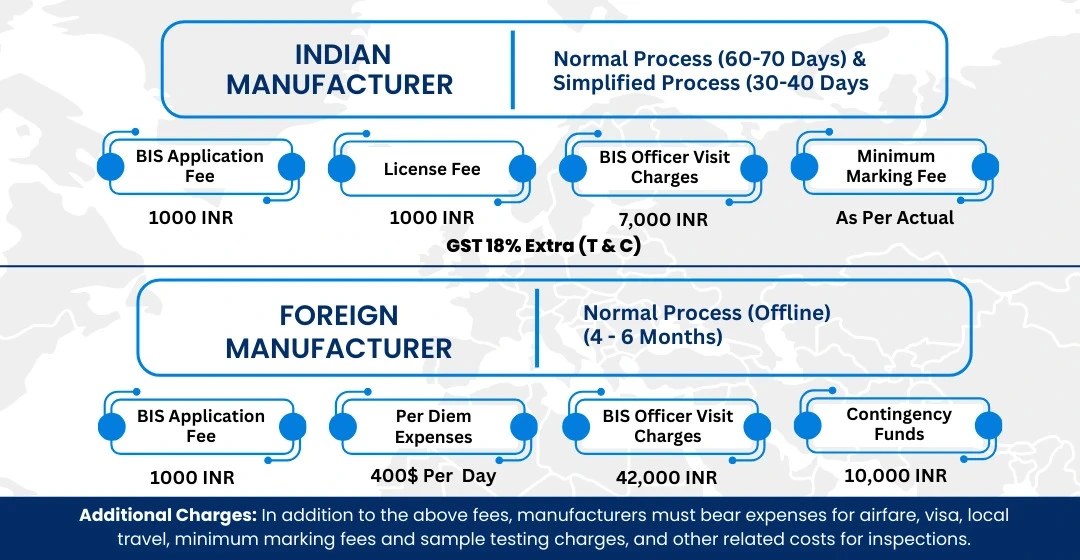BIS Certification for Specification for Low Carbon Steel Wire for Rivets for use in Bearing Industry IS 4882: 1979

Product Description
BIS Certification
for the Specification of Low Carbon Steel Wire for Rivets used in the Bearing
Industry (IS 4882: 1979) is essential for meeting Indian quality standards,
ensuring both durability and performance. This certification is critical for
manufacturers who supply steel wire for rivets in the bearing industry, as it
guarantees product safety and reliability.
The certification process involves thorough testing and extensive documentation to align with BIS norms. BIS Certification for the Specification of Low Carbon Steel Wire for Rivets used in the Bearing Industry (IS 4882: 1979) boosts market credibility, ensures regulatory compliance, and assists smooth product acceptance in India's competitive manufacturing sector.
Introduction
Getting your BIS
Certification for the Specification for Low Carbon Steel Wire used in Rivets
within the Bearing Industry, according to IS 4882: 1979, is essential for
maintaining product quality and sticking to the standards set by the Steel
& Steel Products (Quality Control) Order, 2024. This certification ensures
that the steel wire meets the required mechanical and chemical properties,
making it safe and reliable for the bearing industry. If you're a manufacturer,
obtaining BIS certification is a must if you want to legally produce, sell, or
import these products in India. Plus, staying compliant improves your product's
reliability, keeps you aligned with regulations, and boosts your market
acceptance.
Why is BIS Certification necessary for Specification for
Low Carbon Steel Wire for Rivets for use in Bearing Industry IS 4882: 1979?
Getting BIS
Certification for Low Carbon Steel Wire used in Rivets for the Bearing Industry
IS 4882: 1979 is critical for ensuring product quality, safety, and compliance
with Indian standards. This certification not only confirms that the steel wire
meets essential mechanical properties, but it also enhances durability and
performance in bearing applications. By obtaining this certification,
businesses can encourage trust with both manufacturers and buyers while
ensuring they meet regulatory standards. Plus, having the BIS Certification for
Low Carbon Steel Wire for Rivets for use in Bearing Industry IS 4882: 1979 can
help businesses boost their reliability in products and stand out in the
competitive market.
Overview of Indian
Standard IS 4882: 1979
IS 4882: 1979 outlines the standards for low carbon
steel wire used in making rivets for the bearing industry. It addresses
important elements such as chemical makeup, mechanical characteristics,
dimensions, and testing procedures, all aimed at guaranteeing durability and
effective performance. Adhering to this standard is essential for ensuring
product quality and safety. BIS Certification for Low Carbon Steel Wire for
Rivets in the Bearing Industry (IS 4882: 1979) confirms that manufacturers
comply with regulatory standards, which boosts product dependability and market
acceptance while making the certification process smoother for businesses in
this field.
Process for BIS Certification
The BIS certification process for Specification for Low Carbon
Steel Wire for Rivets for use in Bearing Industry IS 4882: 1979 involves
multiple steps designed to thoroughly evaluate a product's compliance with the
required standards. Here is a general overview of the certification process:
1. Application Submission:
Manufacturers must submit an application form along with the required
documentation to BIS.
2. Documentation Review: BIS
reviews the submitted documents to ensure completeness and correctness.
3. Factory Inspection: BIS
officials conduct an on-site inspection of the manufacturing facility to assess
the production process and quality control measures.
4. Sample Testing: Product samples
are taken and tested in BIS-approved laboratories to verify compliance with
Indian standards.
5. Certification Grant: Upon
successful completion of the inspection and testing, BIS grants certification,
allowing the manufacturer to use the BIS mark on their products.
Documents Required for BIS Certification
To apply for BIS certification, manufacturers need to submit the following documents:
● Application form
● Manufacturing process details
● Quality control plan
● Test reports from BIS-approved laboratories
● Factory layout and equipment details
● Proof of business registration
● Product specifications and technical details
● Declaration of conformity to Indian standards
Additionally, manufacturers may be required to provide proof of compliance with environmental and safety regulations, depending on the specific type of product being certified.
BIS ISI Mark Certification Costing And Timeline
To Know The Process in Detail, Please Visit:
Under BIS Registration Products ISI and CRS
Conclusion
To wrap things up, getting the BIS Certification for Specification for Low Carbon Steel Wire for Rivets for use in Bearing Industry IS 4882: 1979 is really important for manufacturers. It helps ensure they meet Indian quality and safety standards. This certification confirms that the steel wire used for rivets has the right mechanical and chemical properties, which boosts the durability and reliability of bearing components. Plus, achieving BIS certification can bolster a company's product credibility, give them a competitive edge, and help them meet regulatory requirements smoothly.
Here at EVTL India,
we focus on providing expert consultancy for BIS certification, making it
easier for manufacturers to navigate through the certification process. Our
committed team ensures compliance with IS 4882: 1979, taking care of
documentation, testing, and approval procedures. With our support, businesses
can enjoy a hassle-free certification journey and maintain high-quality
standards in their production. Don’t hesitate to reach out to us today to get
your BIS Certification for Specification for Low Carbon Steel Wire for Rivets
for use in Bearing Industry IS 4882: 1979 without any fuss.
Free Call Back
Latest News & Update
📅 BIS Critical Component List (CCL) Updates for Solar PV Modules
🕒 BIS Fee Concessions for MSMEs and Startups | EVTL India
📅 Guidelines for Implementation of Essential Requirements for Security of CCTV
🕒 Machinery and Electrical Equipment Safety (Omnibus Technical Regulation) Order, 2024
🕒 Extension of Timeline for Filing Annual Returns by Battery Producers
📅 Extension of Timeline for Filing Quarterly and Annual Returns for E-Waste
🕒 Extension of Concurrent Running Period for IS 302-1: 2008 and IS 302 (Part 1): 2024























